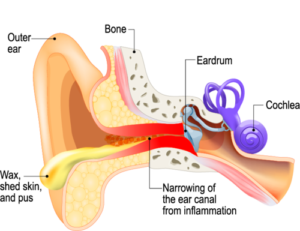A Doctor’s Guide on Hearing Loss
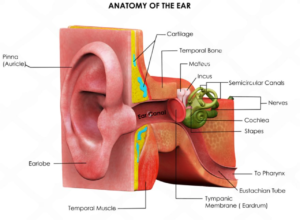
The human ear handles more than 400,000 sounds each day making it one of our most impressive sense organs. To understand this amazing natural feat, we need to know the ear’s parts and how they work together.
Your hearing relies on a complex series of events involving three separate ear areas. Each section has an important job – from catching sound waves to changing them into signals your brain can understand.
This complete guide shows how each part of your ear affects your hearing health common issues that might occur, and practical steps to protect your hearing. If you’re dealing with hearing problems or just want to keep your ears healthy, knowing these basics is key.
1. Basic Structure of the Ear
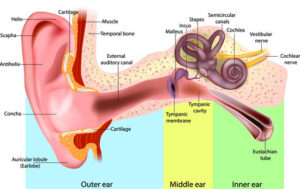
Your ear parts work together like instruments in a well-tuned orchestra. The ear has three main sections each with a specific job to change sound waves into signals we can understand.
a. Outer ear: Your first defense

The auricle (also called pinna) collects sound, like a backward megaphone that guides sound waves into your ear canal. This part you can see makes special earwax to protect against dirt and bugs. The ear canal goes from the auricle and sends these sound waves straight to your eardrum – a bendy, oval-shaped skin that separates the outer and middle ear.
b. Middle ear: The sound booster

Behind your eardrum sits an amazing sound booster. This space filled with air contains three small bones – the malleus (hammer), incus (anvil), and stapes (stirrup) – which together make up the ossicles. These bones create a complex lever system that has an impact on sound force making it 100 times stronger. Also, the middle ear has the Eustachian tube, which links to your throat and keeps the right air pressure, to make sure sound travels well.
c. Inner ear: The sound processor

Your inner ear contains the most advanced sound processing system in your body. The cochlea, a fluid-filled structure shaped like a snail’s shell, sits at its core. This spiral chamber houses about 25,000 specialized nerve endings that convert mechanical vibrations to electrical signals. The cochlea has an accurate design – hair cells near its wide end detect high-pitched sounds, while those closer to the middle respond to lower frequencies.
The inner ear also includes the vestibular system, which consists of fluid-filled semicircular canals that help you keep your balance. These canals work with the cochlea making the inner ear an organ with two purposes: hearing and maintaining equilibrium.
2. How Sound Travels Through Your Ear
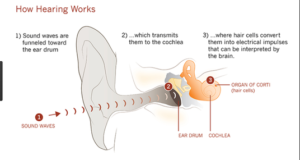
Sound waves take an amazing trip through your ear changing several times before you can recognize them as sounds. This complex process needs different parts of your ear to work together turning air vibrations into signals that make sense.
a. Step 1: Sound collection
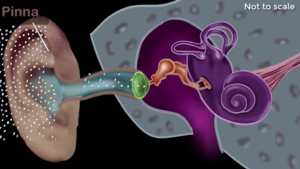
Sound waves first hit the pinna, which gathers sound . The pinna’s special shape helps you figure out where sounds come from. Then, these waves go through the ear canal, which boosts sounds between 2,000 and 7,000 hertz – this helps you hear consonant sounds in speech more .
When sound hits your eardrum, a membrane as thin as paper, it produces specific vibrations. How intense these vibrations are determines how loud the sound is, while how fast they vibrate determines its pitch.
b. Step 2: Sound transmission
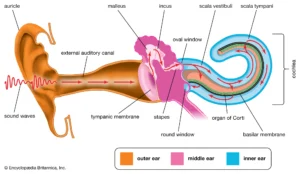
The middle ear changes these vibrations through a clever mechanical system. The movement of your eardrum sets off a chain reaction in the ossicles. These small bones boost the sound force a lot – by the time it gets to the inner ear, the pressure has gone up at least 17 times.
The stapes, your tiniest bone rocks against the oval window making waves in the inner ear fluid. This system has an impact on a key challenge – changing air-carried sound waves into fluid vibrations, which would otherwise lose up to 35 dB of power.
c. Step 3: Sound interpretation

In the cochlea, sound goes through its last change. The fluid’s movement creates a traveling wave along the basilar membrane where about 25,000 special nerve endings pick up different parts of sound. Interestingly certain areas of the cochlea react to different pitches – hair cells near the wide end catch high-pitched sounds like baby cries, while those near the middle respond to lower pitches like dog barks.
These hair cells transform mechanical vibrations into electrical signals through an interesting process. As they move small projections called stereocilia bend, which opens special channels. This allows chemicals to flow in. The electrical signals that result travel through the auditory nerve to your brain. Your brain processes these signals in the temporal lobe. In this area, your brain separates important sounds from background noise and figures out their location and meaning.
3. Common Problems in Each Ear Part
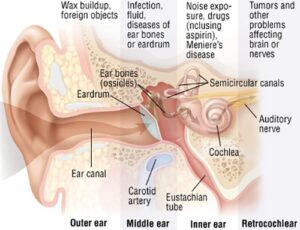
Ear health issues can show up in each part of your ear. Different symptoms point to various conditions. Knowing about these problems helps you recognize when you might need to see a doctor.
a. Outer ear issues and symptoms
The outer ear faces tough challenges due to its open exposure to the surroundings. Swimmer’s ear (otitis externa) affects about 1 in 10 people at some point in their lives. This condition happens most often in adults aged 45 to 75.
Common signs of outer ear issues include:
- Bad earache that gets worse when you touch the ear
- Itchy and red inside of the ear canal
- Fluid leaking or draining
- Short-term hearing problems
- Feeling of fullness in the ear
It’s worth pointing out that earwax buildup is the most common reason for hearing loss that can be treated especially in older people. What’s more small injuries from cotton swabs or using earbuds a lot can make infections more likely to happen.
b. Middle ear complications

Middle ear issues often come from how the ear and throat work together. Acute otitis media, a common infection in the middle ear, affects 75% of kids under 10 years old. This infection starts after someone gets sick with an upper respiratory illness when bacteria move through the Eustachian tube.
Middle ear problems often show clear patterns. For about one in three people, symptoms get bad enough to mess up their daily life. Fluid behind the eardrum called otitis media with effusion, can stick around for months even after the main infection goes away.
The middle ear’s complex makeup leaves it open to many issues. In fact bacterial infections here involve Streptococcus pneumoniae (40% of cases) and Haemophilus influenzae (25% of cases). These infections can have an impact on hearing for a short time, change pressure, and in rare cases, cause more serious problems like bone damage.
Middle ear issues clear up in 3 to 5 days without special care. But if problems arise, they often need immediate antibiotics in a hospital. Kids who get ear infections often have a higher chance of long-term hearing loss.
4. Warning Signs by Ear Region
Spotting warning signs in different ear parts helps stop serious issues. Each area shows unique signs that need a doctor’s look.
a. External ear red flags

The outer ear’s open spot makes it easy to get certain troubles. Bad ear pain that gets worse when you touch the ear or move your jaw needs quick help. Red or swollen skin around the ear canal in people who swim or use earbuds a lot, points to a possible infection.
Key warning signs for the external ear include:
- Fluid coming out if it’s thick, yellow, or smells bad
- Full blockage of the ear canal
- Temperature over 100.4°F (38°C)
- Swollen lymph nodes in the neck
- Ongoing itching or discomfort
b. Middle ear warning signs
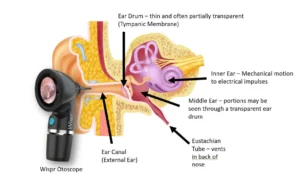
Middle ear problems often take time to develop. So, pain that lasts more than three days needs a doctor’s check. What’s more concerning is that about 615,000 people in the United States face serious middle ear issues each year.
People with diabetes or weak immune systems have a higher chance of getting sick. For sure, you need to see a doctor right away if you feel pressure that won’t go away, your hearing is muffled, or fluid builds up behind your eardrum. Also, if anything leaks through a hole in your eardrum, you should get medical help fast.
c. Inner ear danger signs

Inner ear issues often show up in clear patterns. While most inner ear infections happen to adults between 30 and 60 years old, these problems can start at any age. If you feel like you’re spinning (vertigo) and you’re having trouble hearing, it might mean you have labyrinthitis.
Meniere’s disease has an impact on 15% to 25% of patients in both ears and shows distinct warning signs. Over time, symptoms can include intense dizziness ringing in the ears, and changing hearing loss. Still, some patients go through such severe spinning that they have “drop attacks,” leading to sudden falls.
Patients should get emergency help if they have a sudden start of bad dizziness along with:
- Eyes moving without control
- Big problems with balance
- Hearing loss that gets worse
- Ringing in the ears that won’t stop
- Weakness or paralysis in the face
In every part of the ear, there are common warning signs that need a doctor’s attention right away. These include unusual vital signs confused thinking, or symptoms that won’t go away. Also, any ear pain that comes with a bad headache numb face, or fever that sticks around needs to be checked out .
5. Protecting Different Parts of Your Ear
Taking care of your ears every day and using smart protection methods help keep your ears healthy. Understanding how to look after your ears prevents damage to all parts and maintains your hearing ability.
a. Daily ear care habits
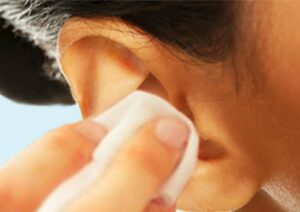
Remember cleaning your ears has a big impact on ear health. Many people do this, but you should never put cotton swabs in your ear canals because they can cause harm or push wax deeper. Instead, use a soft cloth to clean the outer ear .
Keeping your ears dry is crucial to ear care. After swimming or bathing, tilt your head to allow water to drain from your ears . If you swim , invest in special earplugs designed for water sports to give your ears extra protection.
Exercise and stress management have a significant impact on ear health. Regular physical activity helps your ears function . In a nutshell good blood circulation from exercise benefits all parts of your ear, including the tiny components inside.
Remember certain medications can damage your hearing. Some drugs can lead to hearing loss known as ototoxicity, if you take excessive amounts or use them long-term. In these situations, it’s essential to follow your doctor’s instructions to maintain healthy ears.
b. Noise protection methods

Noise exposure limits have a significant impact on safeguarding our hearing. Sounds below 70 decibels don’t put our ears at risk. Along with this information, it’s essential to recognize when to shield your ears – any environment with higher noise levels requires safety precautions.
Different types of ear protection offer unique benefits:
- Earplugs: These fit inside your ear canal. You can choose from moldable, pre-shaped, or custom-fit options. They work well to block constant noise and stay comfortable for extended wear.
- Earmuffs: These cover your entire outer ear attached to a headband or hard hat. They’re ideal for situations where you need to remove and put them on .
- Canal caps: These rest at your ear canal entrance held by a lightweight band. They offer protection against intermittent noise.
The effectiveness of hearing protection hinges on its fit and consistent use. Taking it off for even a short time in noisy conditions reduces its protective power. When noise levels exceed 100 dBA, it’s necessary to use both earmuffs and earplugs together.
Protection in the workplace requires special attention. In industrial settings plastic earplugs or earmuffs filled with glycerin can provide good hearing protection. For workers frequently exposed to workplace noise regular hearing tests help to monitor the protection’s effectiveness.
When it comes to fun activities, you’ve got some special options to protect your ears. Take musicians’ earplugs, for instance. They cut down on noise but don’t mess with sound quality. Hunters also benefit from custom-made ear protection that allows them to stay alert while blocking out the harmful noise from gunshots.
To keep your ear protection working well, you need to take care of it. check for any damage, replace ear cushions when they get hard, and make sure headbands stay snug. All these steps help your protection do its job. Also, storing your ear guards in a clean dry place will make them last longer and keep them in good shape.
Conclusion

Understanding how your ears are built and function is essential to maintain good hearing as you grow older. Every part of your ear – from the outer section that catches sound to the complex inner portion that processes it – works together to handle the numerous noises you encounter .
Sound waves undergo an incredible journey transforming from simple air vibrations to signals your brain can interpret. This complex process relies on all parts of your ear being in good health, so it’s vital to protect and care for them.
Recognizing warning signs helps prevent major issues. While many ear problems resolve on their own certain symptoms indicate you should see a doctor . Don’t ignore severe pain persistent dizziness, or sudden hearing loss.
Everyday habits have a strong influence on ear health. Basic routines like cleaning keeping ears dry, and protecting from loud sounds safeguard your hearing system. Although wearing earplugs can be annoying, the long-term benefits outweigh any short-term inconvenience.
Remember that hearing loss creeps up . Regular check-ups with a doctor after age 50 help catch potential issues before they become serious. By learning how to care for your ears and putting this knowledge into practice, you can maintain sharp hearing well into your later years.

